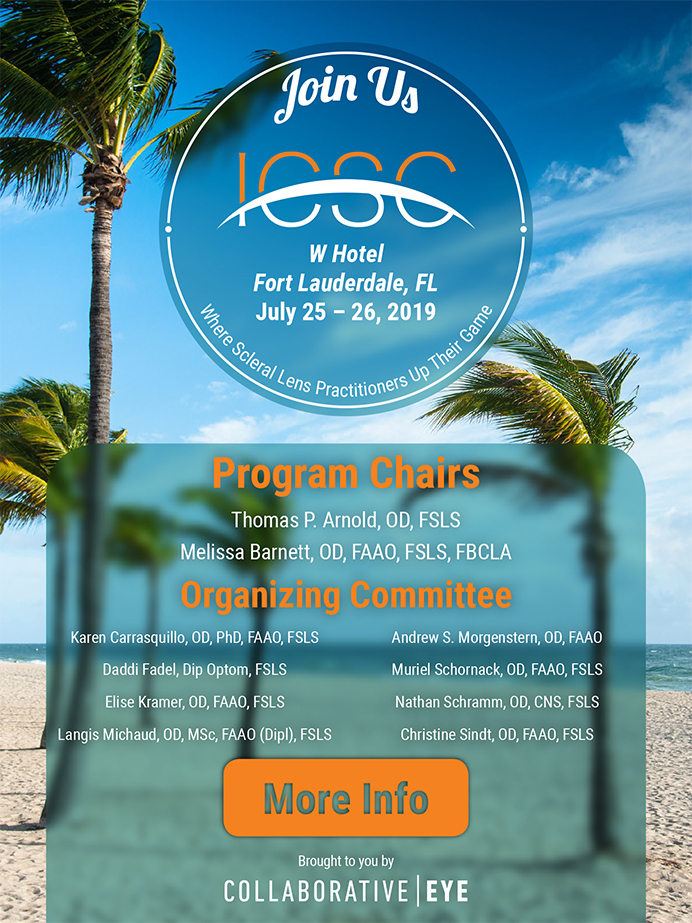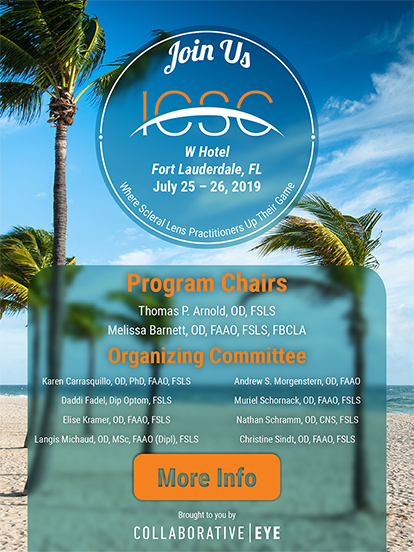In my clinical experience, the typical dry eye patient profile has changed over time to include a range of demographics. One group that interests me is patients in their 20s who exhibit some surprising dry eye characteristics and treatment preferences.
MEIBOGRAPHY RESULTS AND PAIN COMPLAINTS
It is not unusual for me to see significant damage to the meibomian glands in 20something patients, which seems discordant with their young age.1,2 We tend to blame screen time —66% of ophthalmologists say they are seeing screen-related eye problems, and 88% of doctors blame smartphone use for the rise in dry eye disease3,4—but we do not have natural history evidence that screen time is a direct or sole cause.
I think that we will soon see large population studies in response to demographics uncovered in the BOSS study, which found dry eye in 14% of patients 21 to 49 and in 15% of patients 50 and older.5 Point-of-care meibography may aid in the development of the natural history data needed to understand the rates of meibomian gland dysfunction (MGD) in young patients. Studies using point-of-care meibography may generate longitudinal data that could inform whether meibomian gland dropout is temporary and reversible or permanent in young adults.
My clinical impression is that, in 20something patients, I am more likely to find cases of pain without stain—that is, dry eye symptoms disproportionate to fluorescein staining. In these cases, it is possible that corneal nerves are sending nociceptive impulses in response to hyperosmolarity,6 but the adaptive immunity damage to the ocular surface has not yet caused corneal damage (seen as staining).
20SOMETHING TREATMENT TRENDS
After a thorough history, examination, and diagnosis, I present the full range of treatment options to my 20something patients. I get them involved in the decision, which helps promote the acceptance and compliance that are so important for success with any chronic, progressive disease. Their treatment options are usually straightforward because their disease tends to be less complex than that of older patients, who may have concurrent health problems and systemic medications.
I have noted these trends in treatment behaviors and preferences among my 20something patients:
Poor Compliance: Compared with older age groups, 20something patients tend to be less compliant in use of nutraceuticals, warm compresses, blink breaks, and artificial tears. They are more likely to doubt and question recommended treatments. For example, if previously undiagnosed rosacea is contributing to their MGD, they may not accept the local-regional connection between their skin and ocular surface.
A Desire for “Drug-Free” Therapy: My younger patients express a desire for drug-free treatment, which may be effective in cases mild dry eye. I might recommend oral omega-3 supplements, preservative-free artificial tears, environmental controls, and a desktop humidifier, as well as a change to prescription-quality topical allergy control instead of oral medications. A checklist lays out positive changes for their home and work environments. The TrueTear neurostimulation device (Allergan) may help patients produce physiologically complete tears on demand.
With these patients, I have a duty to explain that medications have an important role in treating dry eye. I educate the patient that occasional steroids may calm flares, topical cyclosporine (Restasis, Allergan) may enhance goblet cell density7 and prevent disease progression,8 and topical lifitegrast (Xiidra, Shire) may provide symptom relief and improve signs of dry eye. I want patients to keep these thoughts in mind in case the drug-free approach is not adequate.
Affinity for Dry Eye Procedures: Two preferences converge to make dry eye procedures popular with my 20something patients: the aforementioned desire for drug-free therapy and the aversion to treating a chronic disease every day for life.
If a patient has moderate disease or thinks that compliance with routine home therapy is unlikely, I often recommend an in-office procedure such as intense pulsed light (IPL) therapy (M22 Optima IPL, Lumenis). This approach uses light energy to target chronic inflammation (the root cause of dry eye) by coagulating telangiectasias, which stimulate the vicious cycle of inflammation. This therapy has a role in decreasing inflammatory markers IL-6 and IL-17,9 and we have observed in our unpublished clinical data that IPL decreases MMP-9. Peer-reviewed literature has discussed improved meibomian gland scores,10 increased tear breakup time, normalized osmolarity, and improved symptoms following IPL treatments.11
Vectored thermal pulsation—of which LipiFlow (Johnson & Johnson Vision) is the perhaps the most familiar—is another popular and effective modality that uses a combination of heat and pressure to melt meibum, thereby reducing obstruction of the meibomian glands and improving function. Other thermal pulsation platforms such as the handheld iLux (Tear Film Innovations) and the small-footprint TearCare System (Sight Sciences) may work for these patients, too.
Starting Small: 20something patients with early disease have not yet experienced the full impact of dry eye, so they may not be ready to make a full commitment to a comprehensive treatment program.
In order to work effectively under such conditions, I might tell a patient to start with oral omega-3 supplements and artificial tears as needed, and to set an alarm every hour on his or her phone that signals a break from screen use. I recommend adjustments to diet, lifestyle, and unnecessary medication exposures (eg, over-the-counter diphenhydramine). I explain that additional treatments can be tried if these first-line therapies are ineffective.
Objective point-of-care testing platforms to evaluate osmolarity (TearLab Osmolarity Test, TearLab) and MMP-9 (InflammaDry, Quidel) help patients understand their response to therapy or the need to escalate therapeutic interventions.
20SOMETHING SUCCESS
Customizable dry eye treatment options are important and, in my experience, well accepted in this young population. Even within the 20something demographic, a 20-year-old patient may have a very different tolerance for daily home treatment than a 29-year-old patient. That’s understandable. We just need to be sure that instead of following a one-size-fits-all protocol, we offer the range of treatment options needed and preferred by our 20something dry eye patients.
- Gupta PK, Stevens MN, Kashyap N, Priestley Y. Prevalence of meibomian gland atrophy in a pediatric population. Cornea. 2018;37(4):426-430.
- Moon JH, Kim KW, Moon NJ. Smartphone use is a risk factor for pediatric dry eye disease according to region and age: a case control study. BMC Ophthalmol. 2016;16(1):188.
- Hoffman M. Survey Data Reveals Major Concerns About Screen Use, Chronic Dry Eye. MD. June 13, 2018. https://www.mdmag.com/medical-news/survey-data-reveals-major-concerns-about-screen-use-chronic-dry-eye.
- Baabdullah, Abumohssin, Alqahtani, et al The association between smartphone addiction and dry eye disease: A cross-sectional study [published online ahead of print, November 29, 2018]. Journal of Nature and Science of Medicine. doi: 10.4103/JNSM.JNSM_51_18.
- Paulsen AJ, Cruickshanks KJ, Fischer ME, et al. Dry eye in the Beaver Dam offspring study: prevalence, risk factors, and health-related quality of life. Am J Ophthalmol. 2014;157(4):799-806.
- Hirata H, Rosenblatt MI. Hyperosmolar tears enhance cooling sensitivity of the corneal nerves in rats: possible neural basis for cold-induced dry eye pain. Invest Ophthalmol Vis Sci. 2014;55(9):5821-5833.
- Kunert KS, Tisdale AS, Gipson IK. Goblet cell numbers and epithelial proliferation in the conjunctiva of patients with dry eye syndrome treated with cyclosporine. Arch Ophthalmol. 2002;120(3):330-337.
- Rao SN. Reversibility of dry eye deceleration after topical cyclosporine 0.05% withdrawal. J Ocul Pharmacol Ther. 2011;27(6):603-609.
- Liu R, Rong B, Tu P, et al. Analysis of cytokine levels in tears and clinical correlations after intense pulsed light treating meibomian gland dysfunction. Am J Ophthalmol. 2017;183:81-90.
- Craig JP, Chen YH, Turnbull PR. Prospective trial of intense pulsed light for the treatment of meibomian gland dysfunction. Invest Ophthalmol Vis Sci. 2015;56(3):1965-70.
- Dell SJ, Gaster RN, Barbarino SC, Cunningham DN. Prospective evaluation of intense pulsed light and meibomian gland expression efficacy on relieving signs and symptoms of dry eye disease due to meibomian gland dysfunction. Clin Ophthalmol. 2017;11:817-827.






